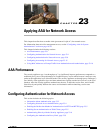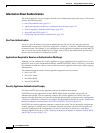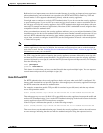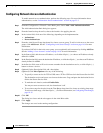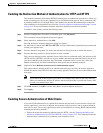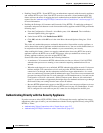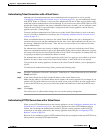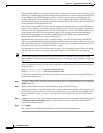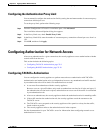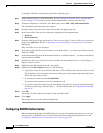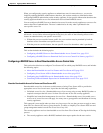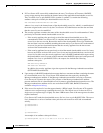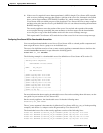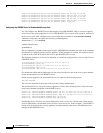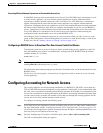
23-8
Cisco ASDM User Guide
OL-16647-01
Chapter 23 Applying AAA for Network Access
Configuring Authentication for Network Access
If the destination HTTP server requires authentication in addition to the security appliance, then virtual
HTTP lets you authenticate separately with the security appliance (via a AAA server) and with the HTTP
server. Without virtual HTTP, the same username and password you used to authenticate with the
security appliance is sent to the HTTP server; you are not prompted separately for the HTTP server
username and password. Assuming the username and password is not the same for the AAA and HTTP
servers, then the HTTP authentication fails.
This feature redirects all HTTP connections that require AAA authentication to the virtual HTTP server
on the security appliance. The security appliance prompts for the AAA server username and password.
After the AAA server authenticates the user, the security appliance redirects the HTTP connection back
to the original server, but it does not include the AAA server username and password. Because the
username and password are not included in the HTTP packet, the HTTP server prompts the user
separately for the HTTP server username and password.
For inbound users (from lower security to higher security), you must also include the virtual HTTP
address as a destination interface in the Access Rule applied to the source interface. Moreover, you must
add a static NAT rule for the virtual HTTP IP address, even if NAT is not required. An identity NAT rule
is typically used (where you translate the address to itself).
For outbound users, there is an explicit permit for traffic, but if you apply an Access Rule to an inside
interface, be sure to allow access to the virtual HTTP address. A static NAT rule is not required.
Note Do not set the uauth timeout duration to 0 seconds when using virtual HTTP, because this setting
prevents HTTP connections to the real web server. See the “Configuring Global Timeouts” section on
page 27-23.
You can authenticate directly with the security appliance at the following URLs when you enable AAA
for the interface:
http://
interface_ip
[:
port
]/netaccess/connstatus.html
https://
interface_ip
[:
port
]/netaccess/connstatus.html
To allow users to authenticate with the security appliance virtual server separately from the HTTP server,
perform the following steps:
Step 1 From the Configuration > Firewall > Advanced > Virtual Access > Virtual HTTP Server area, check the
Enable check box.
Step 2 In the Virtual HTTP Server field, add the IP address of the virtual HTTP server.
Make sure this address is an unused address that is routed to the security appliance. For example, if you
perform NAT for inside addresses accessing an outside server, and you want to provide outside access
to the virtual HTTP server, you can use one of the global NAT addresses for the virtual HTTP server
address.
Step 3 (Optional) If you are using text-based browsers, where redirection does not happen automatically, check
the Display redirection warning check box. This enables an alert to notify users when the HTTP
connection is being redirected.
Step 4 Click Apply.
The virtual server is added and the changes are saved to the running configuration.




